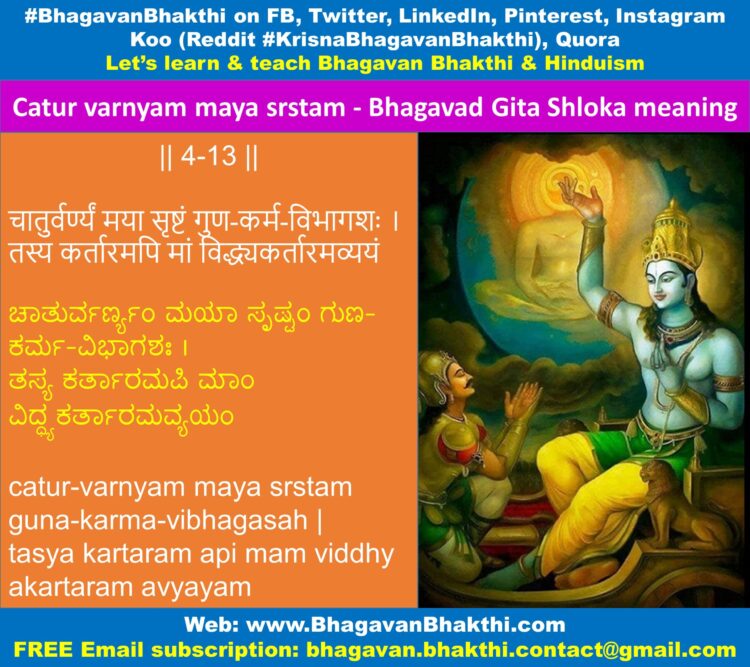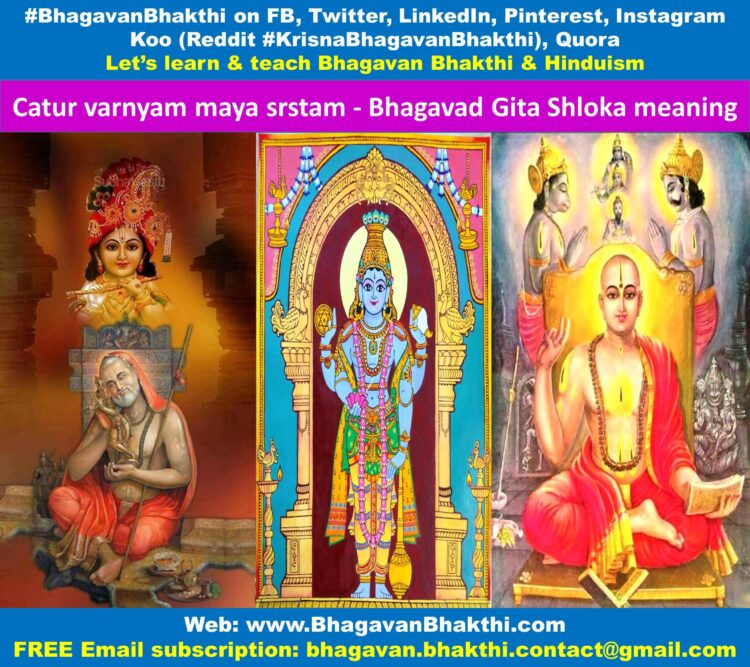Catur Varnyam Maya Srstam – Bhagavad Gita Sloka Meaning | What is the 4.13 verse of Bhagavad Gita? | What is the chapter 4 of Bhagavad Gita Shlokas 13 in Sanskrit?
Namaste friends, how are you doing today? Welcome to #BhagavanBhakthi website / blog.
Bhagavan Lord Sri Vishnu (Krishna, Rama, Trivikrama, Narasimha, Vamana, Vasudeva, Mukunda) and Goddess Lakshmi (Rukmini, Satyabhama, Sita, Kamala, Maya) blessings to you and your family!
In this website / blog, you will always learn about #Hinduism #Sanskrit language.
Also subscribe to my YouTube channel from this link #BhagavanBhakthi to view videos about #Hinduism #Sanskrit language.
Just before going to “Catur Varnyam Maya Srstam – Bhagavad Gita Sloka Meaning | What is the 4.13 verse of Bhagavad Gita? | What is the chapter 4 of Bhagavad Gita Shlokas 13 in Sanskrit?“, let us have a brief some brief information.

Bhagavad Gita is one of the most divine granthas (Hindu texts) not only for Hindus, but for the whole world and to the whole humankind.
Just before the start of the Mahabharata (Kurukshetra) war, Bhagavan Sri Krishna in the form of Gita (divine song) preaches this to his friend and great devotee Arjuna.
But, we should always remember that Bhagavan Sri Krishna not just preached the great Bhagavad Gita only to Arjuna.
No, it’s not like that. Bhagavan Sri Krishna has preached the great Bhagavad Gita to all and especially to the Kali Yuga people as we lack the correct knowledge of Sanatana Dharma.
Thus we should keep this in our mind that, Bhagavad Gita is for the wellbeing of all the living beings on earth.
Bhagavad Gita = Bhagavan’s + Gita = Bhagavan Sri Krishna preaches in the form of Gita (divine song) and thus the name Bhagavad Gita.

Lord Sri Krishna preaching Bhagavad Gita to Arjuna just before the start of the Mahabharata (Kurukshetra) war.
Now let us come to the sloka (sloka / hymn) of Catur Varnyam Maya Srstam as given below:
चातुर्वर्ण्यं मया सृष्टं गुण-कर्म-विभागशः । तस्य कर्तारमपि मां विद्ध्य कर्तारमव्ययं || 4-13 ||
ಚಾತುರ್ವರ್ಣ್ಯಂ ಮಯಾ ಸೃಷ್ಟಂ ಗುಣ-ಕರ್ಮ-ವಿಭಾಗಶಃ । ತಸ್ಯ ಕರ್ತಾರಮಪಿ ಮಾಂ ವಿದ್ಧ್ಯ ಕರ್ತಾರಮವ್ಯಯಂ || 4-13 ||
cāturvarṇyaṁ mayā sr̥ṣṭaṁ guṇa-karma-vibhāgaśaḥ। tasya kartāramapi māṁ vid’dhya kartāramavyayaṁ || 4-13 ||
Meaning of the above shloka : chatur-varnyam = The four varnas / divisions of human society; mayaa = Done by Me (Sri Krishna); srstam = Created;
guna = quality; karma = Karma; vibhagasah = In the form of division; tasya = Of that; kartaram = The father;
api = although; mam = Me (Sri Krishna); viddhi = you may know; akartaram = As the non-doer; avyayam = Being unalterable.
Translation of the above shloka : I (Sri Krishna) have created four Varnas, that is, Brahmana, Kshatriya, Vaishya and Shudra based on the Karma and deeds of Jeevas (living beings).
And, although I am the creator of these four varnas, you should always remember that I am (Sri Krishna) yet the non-doer and being unalterable.
A great saint of Sri Madhwa (Dvaita) Sampradaya (tradition), Sri Raghavendra Swamy has given an extensive explanation for this shloka (sloka / hymn) with the help of Sri Madhwacharya Ji’s commentary.

Left: Sri Raghavendra Swamy; Middle: Lord Sri Krishna; Right: Sri Madhwacharya Ji – He re-established Dvaita Sampradaya (Duality Tradition).
This Varna system explained is not limited to only India, but is applicable to the entire humanity. On the outward way it may look like Bhagavan Sri Krishna has created these four varnas, that is, Brahmana, Kshatriya, Vaishya, Shudra.
But Sri Madhwacharya Ji says this classification is not based purely on the body, but is based on aatma / soul. Each aatma / soul has very unique nature of its own.
This means, every aatma / soul is different from each. My aatma / soul is different from your aatma / soul. Many of us know that aatmas / souls have been widely divided into three, that is, Satvika, Rajasa and Tamasa.
Satvikas include all the Devatas / Demigods. Tamasas include the Asuras and lowest level of humans. Rajasas has again divided into three divisions, that is, Rajasa-Satvika, Rajasa-Rajasa, Rajasa-Tamasa.
And again amidst these, Rajasa-Satvika group is divided into chaturvarnya i.e, Brahmana, Kshatriya, Vaishya and Shudra in Bhagavad gita.
If an aatma / soul (with the combination of Rajasa and Satvika) has greater (too high) ‘Satvika guna’ than ‘Rajasa Guna’, then he will be called as a Brahmana.
If ‘Satva Guna’ is a little more than ‘Rajasa Guna’, than he will be called as a Kshatriya. If ‘Satva Guna’ and ‘Rajo Guna’ are equal in quantity, then he will be called as a Vaishya.
If ‘Rajo Guna’ is higher than ‘Satva Guna’, then he will be called as a Shudra. This is the correct meaning of Chatur Varna as per Hinduism / Sanatana Dharma.
More information will be added to this on regular basis, please visit after some time to know more information.
To watch videos on #Hinduism #Sanskrit language, SUBSCRIBE to my YouTube channel from this link: #BhagavanBhakthi YouTube channel
To watch the YouTube video about “First shloka of Bhagavad Gita with meaning”, click the below YouTube video link:
To know about Srimad Bhagavad Gita with meaning, please visit this link : Srimad Bhagavad Gita with meaning
To know “Why should we read Bhagavad Gita”, click this link: Why should we read Bhagavad Gita
To know “Srimad Bhagavad Gita full lyrics in Kannada”, please visit this link: Srimad Bhagavad Gita full lyrics in Kannada
To know “Srimad Bhagavad Gita full lyrics in English”, please visit this link: Srimad Bhagavad Gita full lyrics in Sanskrit (Hindi)
To know “Srimad Bhagavad Gita full lyrics in English”, please visit this link: Srimad Bhagavad Gita full lyrics in English
Dear friends, if you need any clarifications about this post, kindly let me know, I will definitely try to answer all of them.
Also your one LIKE, one COMMENT, One Share, one SUBSCRIPTION is highly important.
This will help to know the quality of this content and also it will be helpful to know if any improvements is required for the content.
If you feel this content is useful to you and has helped you to improve your knowledge, kindly share this with your well-wishers.
Because “SHARING MEANS CARING”.
To receive FREE EMAIL SUBSCRIPTION about #BhagavanBhakthi, you can send an email to [email protected] from your email ID.
NAMASTE!
Sri Gurubhyo Namaha
Sri Krishnaayana Namaha
Sri Krishnaarpanamastu
Share in Social Media